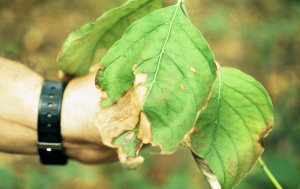
See all posts by this author

Photo courtesy of Terry S. Price, Georgia Forestry Commission, Bugwood.org
Dogwood anthracnose is a serious disease caused by the fungus Discula destructiva. It affects flowering dogwood trees, leading to large, tan to brown lesions on the leaves, dieback of twigs, and premature leaf drop. If left untreated, it can be lethal to the tree.
Of course, prevention and treatment for dogwood anthracnose is included in a Plant Health Care subscription from Arborscapes. (As are myriad other pests and diseases) If you would like to become a part of our Plant Health Care program, reach out to Arborscapes today! Your living landscape will be the envy of the entire neighborhood!
Here’s how to manage and treat dogwood anthracnose:
Cultural and Physical Controls:
- Proper Spacing: Ensure dogwood trees are well-spaced to improve air circulation, which can help reduce the humidity around the tree — a condition favorable to fungal growth.
- Pruning: Regularly prune and remove dead or infected branches and twigs. This not only reduces the source of the fungus but also improves air circulation. Always disinfect pruning tools between cuts with a solution of 10% bleach or 70% alcohol.
- Watering: Avoid overhead watering, which can wet the foliage. Instead, water the base of the tree to keep leaves dry.
- Site Selection: If planting new dogwoods, choose a location with good air circulation and morning sun, which helps dry dew quickly.
Chemical Control:
- Fungicides: Protective fungicides can be effective when applied in the spring as buds break and leaves emerge. Continue applications at intervals recommended on the product label until weather conditions are no longer conducive to the disease.
- Multiple Applications: To be effective, fungicides might require multiple applications, especially during wet, humid conditions which are conducive for the spread of the fungus.
Sanitation:
- Fall Cleanup: In the autumn, rake and remove fallen leaves and debris around the tree. This will help reduce the number of fungal spores that can reinfect the tree the following spring.
- Dispose of Infected Material: When removing infected branches or leaves, dispose of them away from healthy trees. Burning (if legal in your area), burying, or bagging and trashing are effective methods.
Resistant Varieties:
- Kousa Dogwood: This variety (Cornus kousa) is more resistant to anthracnose than native flowering dogwoods. If anthracnose has been a recurring problem, consider planting Kousa dogwoods.
Stress Reduction:
- Trees under stress are more susceptible to diseases. Ensure your dogwood trees are well-watered during dry periods and consider a balanced fertilizer to maintain tree health. Avoid injuring the bark.
Regular Monitoring:
- Regularly inspect your dogwood trees for symptoms of anthracnose, especially in spring and during wet, humid periods. Early detection and intervention can help manage the disease more effectively.
Remember to always read and follow label instructions when applying fungicides. Combining cultural practices with timely fungicide applications will provide the best protection against dogwood anthracnose.
And if all of this sounds like too much work, contact Arborscapes to subscribe to our Plant Health Care program, and we will take care of this, other pests, fertilization and health concerns for your living landscape!
Dogwood photo by Isabella Fischer.
See all posts by this author
